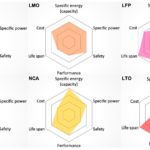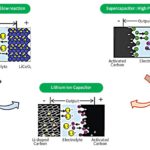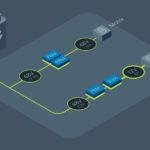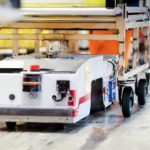Small self-powered systems, including wireless sensors and small robots currently under development, can use triboelectric nanogenerators (TENGs) and piezoelectric nanogenerators (PENGs) as prime power sources. TENGs and PENGs offer large open circuit voltages, low materials cost, ease of fabrication, and good energy conversion efficiencies.
TENGs use triboelectricity, commonly called static electricity, to convert common mechanical energy sources into electric power. In a TENG, electric charges are separated on the contact surfaces, and an electrical potential is generated between the surfaces. The alternating potential resulting from the dynamic mechanical motions can be used to charge a battery or for powering electric devices such as a wireless sensor. In addition, the potential profile, or the current profile, of a TENG can be used as a sensor to monitor motion or various chemicals.

TENGs have been fabricated with an area power density up to 500 W/m2 and instantaneous conversion efficiency of about 70%. In contrast with conventional electromagnetic generators, TENGs have their best performance at low frequencies (<5–10 Hz). They are well suited for harvesting energy from body motions, ocean waves, and similar low-frequency sources of motion. Four fundamental operational modes have been identified for TENGs.

Vertical Contact-Separation Mode – Two dissimilar dielectric films are stacked and have electrodes on the top and bottom of the stacked structure. A physical connection between the two dielectric films creates oppositely charged surfaces. When the two surfaces are separated by a small gap caused by vibration or other mechanical energy, a voltage potential is created, which can be used to power an external load. Once the gap is closed (by an opposite vibration), the triboelectric charge created potential disappears, and the electrons flow back.
Lateral Sliding Mode – The structure to start with is the same as that for the vertical contact-separation mode but relies on a sliding motion rather than a vibrational motion to create triboelectric charges on the two surfaces. The sliding can be a planar motion, a cylindrical rotation, or disc rotation.
Single-Electrode Mode – This mode is designed for use in mobile systems where the TENG object can’t be electrically connected to the load because it is part of the mobile system. For example, to harvest energy from a person walking across a floor, the electrode on the bottom part of the TENG is grounded. Motion between the electrode and ground changes the local electrical field distribution. There are electron exchanges between the bottom electrode and the ground to maintain the potential change of the electrode. This energy harvesting strategy can be in both contact-separation mode and contact-sliding mode.
Freestanding Triboelectric-Layer Mode – Triboelectricity (static electricity) is also generated by moving objects resulting from contact with air or other objects such as walking across a carpet. That charge can be harvested using a pair of symmetric electrodes underneath a dielectric layer. The object’s oscillating motion relative to the electrodes creates an asymmetric charge distribution in the media, causing electrons to flow between the two electrodes. The moving object does not have to be directly in contact with the top dielectric layer of the electrodes. This mode of operation reduces friction and surface wear and results in highly durable TENGs.
Piezoelectric nanogenerators
The piezoelectric effect can also be used for motion sensing and energy harvesting. In a piezoelectric material, an electric charge can be generated due to a change in polarization due to the application of mechanical stress. In the figure below, the piezoelectric material starts in a stress-free state (I). If the material is polarized to a level, Ps, such as in a poled ferroelectric material, the charge will collect at the material surface to maintain a charge balance. The application of compressive stress (II) decreases the level of polarization, and surface charge can flow and power an external load. When the stress is removed, or tensile stress applied (III), the polarization level of the material increases, causing the current to flow in the opposite direction.

In addition to using bulk piezoelectric materials to generate electricity, various nanostructured piezoelectric energy harvesters have been demonstrated. These PENGs include single-strained zinc-oxide nanorods, nanorod arrays, flexible substrates, and a growing list of other structures and piezoelectric materials. Most PENGs generate ac power.
PENGs have been fabricated using nanostructures (NS) such as that illustrated below to generate dc voltages. When a force is applied to move the tips of the NS, it becomes stressed and deformed, which leads to the generation of an electric field. The force can be perpendicular to or parallel with the NS. The figure below shows a schematic of a PENG when a force is exerted perpendicularly to the direction of the axis of the nanogenerator. One portion at the tip of the NS undergoes expansion, while the other portion undergoes compression. The compressed end exhibits a positive strain and a positive electric potential, whereas the other end exhibits a negative strain as well as a negative electric potential. Hence, electrical energy is distributed at the ends of the NS. The ohmic contact formed between the bottom metal electrode and the NS causes neutralization of the electric field generated at the tip of the NS.

In this particular NS, a Schottky contact is formed between the top metal electrode and the top of the nanorods. This PENG generates electricity when the top metal electrode is in contact with the tip of the stressed NS. The Schottky contact rectifies the current flow and produces a dc voltage.
Combining TENGs and PENGs
Multifunctional sensing and self-powered and flexible devices are being developed that integrated both TENGs and PENGs. These hybrid soft systems can implement more complex sensing and produce more power than is possible with a single technology. Future generations of wearable devices and soft robots are expected to benefit from combined TENG and PENG systems. TENGs and PENGs can be used together as discrete and separate nanogenerators or combined in a single hybrid structure.
For example, a flexible, woven textile device has been produced that includes various features, including capacitive tactile sensing, piezoresistive strain sensing, and TENG and PENG energy harvesting. The device consists of a piezoelectric composite, polydimethylsiloxane (PDMS), carbon nano tubes (CNT), and silver nanowire layers. The CNT improves the piezoelectric properties by using the conductive nanotubes to enhance the internal electric field in the materials. The triboelectric effect was strengthened with the PDMS hemispherical structures formed on the warp functional threads providing a large contact area and gradual contact and separation motion. The device can detect the tactile force and position by measuring the capacitance and the strain force using resistance. At the same time, the electrical power can be generated by the TENG- and PENG-based energy harvesting. The structure consists of 10 x 10 sensor arrays in a 20 mm x 20 mm area. The maximum power was 108 mW from the TENG and 60.6 mW from the PENG. Operating with a frequency of 4Hz, the peak-to-peak open circuit voltage is about 12V for the TENG and 18V for the PENG.
In another development, a hybridized nanogenerator combining triboelectric and piezoelectric energy harvesting in a single structure has been fabricated. By sharing electrodes, the flexible PENG was coupled with a single-electrode TENG. The combination of piezoelectric and triboelectric effects greatly enhanced the output of the hybrid nanogenerator. The hybrid PENG/TENG structure produced 85 mW at 48V.
Summary
TENGs and PENGs are versatile technologies used for sensors and energy harvesting in wireless sensors, small robots, wearables, and similar applications. Both TENGs and PENGs convert mechanical energy into electric power, making them complementary technologies, and they are compact devices with good efficiencies. Discrete TENGs and PENGs can be used in the same system to improve overall performance. Hybrid structures that incorporate triboelectric and piezoelectric harvesting can be built to produce higher output voltages.
References:
A retrospect on the role of piezoelectric nanogenerators in the development of the green world, Royal Society of Chemistry
Material aspects of triboelectric energy generation and sensors, NPG Asia Materials
Nanogenerator, Wikipedia
Triboelectric and Piezoelectric Nanogenerators for Future Soft Robots and Machines, iScience
Triboelectric Nanogenerators, Springer e-book





